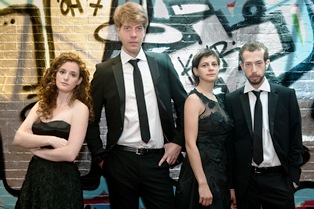
Ariel Quartet Caps Beethoven Cycle Splendidly
How does it feel to climb Mount Everest?

Ask members of the Ariel Quartet, quartet-in-residence at the University of Cincinnati College-Conservatory of Music, who finished a cycle of the complete string quartets of Beethoven Saturday night in CCM’s Corbett Auditorium. For violinists Alexandra Kazovsky and Gershon Gerchikov, violist Jan Grüning and cellist Amit Even-Tov, it was a feat that had added significance, as none of them has yet turned 30-years-old.
The program, as have all six in their cycle (Jan. 23-March 29), blended early, middle and late works for a welcome overview of the composer’s output. For Saturday’s final concert, they performed Beethoven’s Op. 18, No. 6 in B-flat Major, Op. 74 in E-flat Major (the “Harp”) and Op. 132 in A Minor.
Gerchikov sat first violin (he and Kazovsky alternate) in the Op. 18 and Op. 74 Quartets, which made up the first half. Op. 18, No. 6, which looks forward to some extent to Beethoven’s late quartets, suffered a bit from heavy-handedness in the first movement, but overall it made a splendid opener. The Adagio cantabile (second movement) made up for in subtlety what was lacking in the opening Allegro, while the Scherzo, with its complex syncopated rhythms, was full of buoyant good humor. The finale, with its “Malinconia” (“melancholy”) introduction -- which repeats twice during the movement -- was beautifully laid out, its light, tripping episodes and blazing conclusion giving the lie to the solemnity of the subtitle.
Op. 74 was dubbed the “harp” by Beethoven’s publisher for its use of pizzicato in the first movement. Like Op. 18, No. 6, it looks both forward and backward and made for thoroughly engaging listening. Proceeding from a lovely slow introduction, the opening Allegro was capped near the end by sudden forte, broken arpeggios by Gerchikov. The following Adagio was sublimely read, while the Scherzo evoked the famous opening motto of Beethoven’s Fifth Symphony (written almost contemporaneously). Grüning made lovely work of the lilting viola variation in the final Allegretto theme and variations.
Kazovsky moved to first violin for Op. 132, which concluded the concert and the Ariel’s journey. In both depth and execution, this was the highpoint of the concert. Known for its central Adagio, which Beethoven inscribed “Heiliger Dankgesang” (“Holy Song of Thanksgiving”), it was written during a time of serious illness for the composer and expresses thanks for his recovery. It was the centerpiece of this performance, as well. The chorale-like main theme was played without vibrato, initially and when repeated during the movement, giving it an uncanny spiritual quality, not unlike an organ. The music warmed in accordance with Beethoven’s inscription, “Neue Kraft fühlend” (“feeling new strength”), and grew earnest before coming to an ethereal end. After the brief Alla Marcia (“march”) and an intense moment for Kazovsky high on the violin’s lowest strings over tremolo accompaniment, the finale (Allegro appassionato) had the aspect of a victory won.
The audience rewarded the players with a heartfelt standing ovation, both in gratitude for the concert and for the entire cycle.
The Ariel Quartet will perform at the 92nd St. Y in New York City May 12 as part of “Cincinnati Week,” a showcase of Cincinnati’s leading arts attractions to be presented May 6-12 in the Big Apple. They will perform Haydn’s Quartet in G Major, Op. 76, No. 1, the String Quartet, Op. 3, by Alban Berg, and Beethoven’s Quartet in B-flat Major, Op. 130 with the “Grosse Fuge.” For tickets and information, visit www.cincyinnyc.com